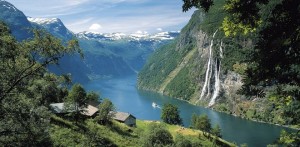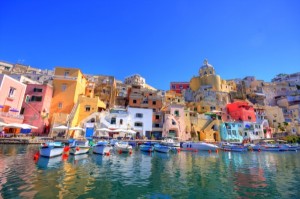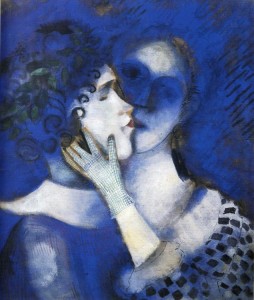This blog will deal with one of my peak travel experiences with Kosher Cruises, which for a change has little to do with anthropology, history or culture.
As a result, I put away my feverish digging for the roots of our Jewish heritage and instead, will try to put into words my awe at the exquisite beauty of nature, far surpassing any man made creation. I truly believe that such sublime manifestation of Natural Creation is bound to remind one of the Divine Being. With all the G-d given talents and abilities we may possess as humans, we could not come close to parallel such magnificent and majestic wonder that invoked feelings of spiritual gratitude to the. For a non-believer, I would not hesitate to claim that such awe inspiring natural creations, are bound to make one think there must be MORE.
The moment I first cast my eyes on the Incredible Geirengerfjord, I was having breakfast in the dining room of the Costa Fortuna, cruising the Balkans. It was early in the morning, the dining room almost empty and I remember thinking about my plan for the day. After 8:30 I was going to take a tour of the small village of Gereninger, take a look at the fjords and return to the ship at 1:00 p.m. I filled the afternoon chock full of planned activities like a spa massage, a facial and blowout, then at 4:00? a lecture by one of my favorite Rabbi’s a humanist of great intellect and humor, the famous and charismatic Rabbi Riskin, an innovator in Orthodox Judaism with his highly sensitive approach to universal human concerns, a creator of a women’s yeshiva for advanced Torah Studies, and a school for women advocates. It was something I’ve been looking forward to very much.
In the late afternoon, I was going to meditate and read on the upper deck, watching the sunset, before getting ready for the evening and generally use the time to relax. Some of my friends had booked us seats for the nights musical show, right after dinner. I smiled thinking; ‘sounds like very hard work, but somebody has to do it’?
So back to breakfast… reflecting on the pleasures of the coming day, as I munched on my freshly baked whole grain bread (smothered w butter) I made a mental note of how perfect the omelet was, how perfect everything was! Sipping my excellent cup of coffee, I looked out to the ocean from the picture windows of the dining room and saw something that took my breath away and made me run closer to window.
Close enough to the ship to make out the topography of the land was a vision that made me stop in mid chew. I ran closer to the window and saw the huge (9 mile long) Geirangerfjord, which as I learnt later, was undoubtably the most beautiful fjord in Norway. The bluest blue, sparkly water surrounded towering, steep rocks, massive mountainsides, with waterfalls enveloped in different shades of green, reaching thousands of feet into the sky. From my vantage point I saw another group of dramatic mountains, separated by separated by rivulets of water, narrow and aquamarine blue, the cliffs jutting out in places as enormous towers. I realized we were in Fjord country, but never saw any as magically magnificent.
I was stunned since my expectation was exceeded by far, and then thought this must be the unforgettably spectacular Geirangerfjord, a UNESCO World Heritage site, known as “the world’s most beautiful fjord”. I could easily see why.
I knew it was probably too late to sign up for any of the more tours. I was more than fine with canceling my spa appointments, even if I had to pay the late cancellation charge and the lecture was at 4:00 pm. Then and there a decision was made: I’ll take whatever is available and just go with it. Downstairs, minutes later, the excursion manager said I was in luck because someone cancelled and I was early enough to take their place. The kayak adventure was it.
Shortly after going to the pier, we were escorted on a short walk to a nearby kayak camp, and given a safety briefing. By the way, previous kayaking experience is not needed and anyone with a life jacket (supplied by the guides) and a sense of adventure can participate.
We were paired two to a kayak and began the 1.5 hr glide along the steep mountain walls, paddling away on the mirror smooth water (the rocky ledges keep the hairpin bends of water virtually wind free, the sunshine highlights the incomparable beauty of the scenery. We passed by the ‘Seven Sisters’ and the ‘Bridal Veil’, that are thundering waterfalls, little farms perched on the rocky ledges and listened to stories about children and animals that had to be tethered so they won’t fall over the steep cliffs.
The kayaking adventure is by far the best way to experience this area, with its hairpin basin curves, and unspeakable beauty. At all times of the year the basin is free from wind between the enormous mountain peaks, and any stress you might have brought with you, dissolves, replaced by peace and a sense of gratitude for Hashemite.
The tour ends at Geiranger, giving you a chance to visit the small town
and you make your way back to the ship. I kept looking back, not having had my foil, looking at the snow peaked mountains, lush vegetation and some of the most spectacular scenery in the world.
In the words of the “Terminator “, I’ll be back.



 On my recent cruise to the The Greek Isles, the itinerary included a 5 hour stop in Dubrovnik, Croatia. I knew about this breath taking, UNESCO World Heritage site, from reading travel publications and interestingly, word of mouth. Dorina, my Croatian hair stylist, an avid traveler and fellow jew, said it was the most beautiful town in Europe period! She was overjoyed when I mentioned we’ll be stopping there and gave me some tips for the ‘must see’ sites, knowing my passion for all things Jewish, especially the little known and ancient.
On my recent cruise to the The Greek Isles, the itinerary included a 5 hour stop in Dubrovnik, Croatia. I knew about this breath taking, UNESCO World Heritage site, from reading travel publications and interestingly, word of mouth. Dorina, my Croatian hair stylist, an avid traveler and fellow jew, said it was the most beautiful town in Europe period! She was overjoyed when I mentioned we’ll be stopping there and gave me some tips for the ‘must see’ sites, knowing my passion for all things Jewish, especially the little known and ancient.  My latest visit to the magnificent city of St. Petersburg, I realized that some travelers don’t have enough time to take in every treasure this extraordinary city has to offer,
My latest visit to the magnificent city of St. Petersburg, I realized that some travelers don’t have enough time to take in every treasure this extraordinary city has to offer,